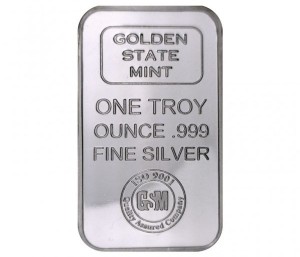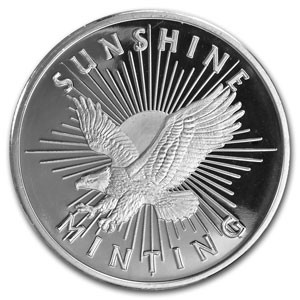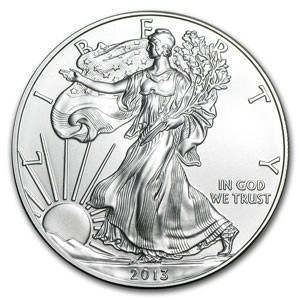When purchasing physical silver, investors have several options. These include silver bars, silver rounds, and silver coins. No one investment strategy is right for all buyers; each of these forms of silver has both pros and cons.
Silver Bars
Silver bars are nearly always rectangular shaped. They are stamped with the name of the company, along with the weight and purity of the bar, which helps investors determine how much silver is contained within the bar. Common silver bar sizes include 1, 10, and 100 troy ounces.

A Brand New Silver Bar from GSM
Silver bars typically carry the lowest premium over spot, making this a popular option for investors who are primarily interested in purchasing as much silver as possible. Their rectangular size is easily stacked and stored.
Most silver bars have a fairly generic design; some investors prefer silver with a more eyecatching style. These investors are often attracted to “art bars,” which carry more elaborate or artistic designs, The value of these bars depends both on the amount of silver and on the desirability or collectibility of the design. Often, these bars are more expensive than generic silver bars.
Silver Rounds
The main difference between silver bars and rounds is that rounds, as the name implies, are round rather than rectangular. Similar to art bars, most carry an artistic design. They are produced by both government and private mints around the world.

A Brand New Silver Round from Sunshine
Like silver bars, silver rounds contain at least .999 pure silver. As with silver bars, they generally carry a fairly low premium over the spot price of silver. Common weights for silver rounds range from half an ounce to 5 ounces. These are a popular option for investors seeking to purchase as much silver as possible, though they are not as widely available as silver bars.
Silver Coins
At first glance, silver coins look much like silver rounds. The main difference is that they carry a legal tender value, and are produced by a government mint as opposed to a private mint. Their purity and weight is backed by the government.
Examples of silver coins include the Canadian Silver Maple Leaf, American Silver Eagle, and Austrian Silver Philharmonic. Often, the design changes from year to year. Certain years are considered to be more collectible than others; these carry a higher premium over the spot price of the silver they contain.

An American Silver Eagle Coin
As numismatic collectibles, silver coins almost always carry a higher premium than silver bars and rounds. This is particularly true for proof or uncirculated coins, which are prized by collectors for their shiny finish and eye appeal. Some investors prefer silver coins for this collectibility factor, while others would rather purchase silver bars and rounds so that they can buy as much metal as possible.
Some silver coins are .999 silver, like bars and rounds, while others contain a smaller proportion of silver, such as 90%. Most silver coins weigh one troy ounce, though they are also available in sizes both smaller (known as fractional coins) and larger. Another type of silver coins is “junk silver,” describing US coins minted prior to 1965, which contain between 35% and 90% silver. One downside is that silver coins tend to be more difficult to store due to their varying dimensions.

